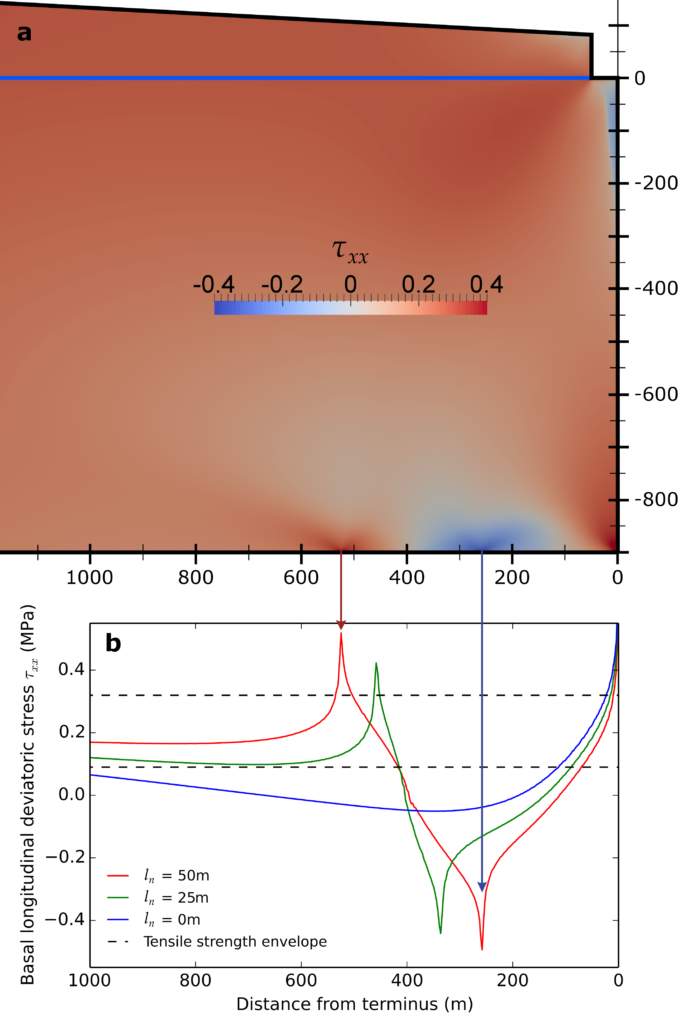The term “iceberg calving” covers the wide range of processes through which intact chunks of ice are discharged to the oceans from the termini of glaciers or the margins of ice shelves.
On one end of the scale, Antarctic ice shelves calve huge tabular icebergs over decades or longer, for example the likely imminent calving of Larsen C. At the other end of the scale, small fast flowing glaciers such as the San Rafael glacier in Chile almost continually calve small chunks of ice into their fjords, which makes for a spectacular tourist attraction!
Calving is an important process of mass loss for the world’s ice sheets, estimated to be responsible for a third of present day mass loss from the Greenland Ice Sheet. Calving is also important in the stability of marine-terminating glaciers, with an initial calving retreat potentially able to destabilise the grounding line and trigger acceleration of the glacier (e.g. Thomas, 2004; see also Isabel’s recent blog post on marine ice sheet instability.
It’s complicated
Despite its importance, a comprehensive understanding of iceberg calving remains elusive, for a number of reasons: its processes occur over a huge range of time and length scales on glaciers around the world; there are limited observations of calving – satellites passing overhead once a day or so will miss most of the action, many important processes are hidden from view beneath the water or at the bed, and the termini of calving glaciers are hazardous environments; and calving is part of a complex feedback cycle along with glacier thinning and ice flow acceleration.
Rates of calving often change annually, with calving slowing or shutting down entirely over the winter. Many different environmental factors such as melting of the glacier surface, undercutting of the calving face by warm fjord water or the resistance from sea ice in fjords combine to promote or prohibit calving.
This raises a problem. Our projections of sea level rise from the ice sheets are informed by computer models that simulate ice flow over continental length scales (see Steph’s blog post). But without an accurate parameterisation of iceberg calving, calving rates and therefore related sea level rise, projections from these models are poorly constrained. To fill in these gaps, computer modellers have been working on simulations of calving glaciers to gain insight into the processes involved in iceberg calving and to recreate the behaviour of glaciers.
The Story in Greenland
The Greenland Ice Sheet drains into the ocean through a series of mighty outlet glaciers. The most famous of these is Jakobshavn Isbrae, the world’s fastest flowing glacier, which is thought to have calved the iceberg that sunk the Titanic. Since the mid 1990s, many of these glaciers have dramatically accelerated, thinned and retreated, calving increasing quantities of ice into the ocean. Calving at these glaciers often takes the form of entire slabs of the calving front detaching and overturning. These slabs can be up to 1000m in height, producing an incredible spectacle. One day I hope to go out to Greenland and witness these myself, but for now some of the spectacular footage on YouTube will have to suffice!
Video footage of a calving event discussed by Fabian Walter caught my attention as being potentially significant. The footage shows a small calving event from the surface of the calving front, followed barely three minutes later by a much larger calving of the whole glacier front. This poses the question of whether the removal of ice from the surface could have increased the buoyancy of the glacier front enough to trigger the second much larger event, within the timescale of minutes.
A simple model
To explore this hypothesis, I’ve built a very simple numerical model. Removing a block of ice from the surface near the calving front to simulate the first calving event induces a large tensile stress at the base of the glacier (the peak of the red curve in (b)) where the glacier is losing contact with the bedrock as it tries to lift. The ice subject to the tensile stress is being pulled apart, potentially allowing crevasses to form at the base which might grow quickly to penetrate the full thickness of the glacier, resulting in calving. At more than 500m upstream from the calving front, this represents a tenfold magnification of the initial minor calving event. Without this block of ice removed, this stress feature is missing from the base (blue curve).
By itself, this simple study isn’t sufficient evidence to prove that this mechanism was responsible for the calving event seen. However, it does leave open the exciting possibility that such a mechanism could be partly responsible for calving at these glaciers, potentially linking the long term calving rate to mechanisms focused at the calving front.

